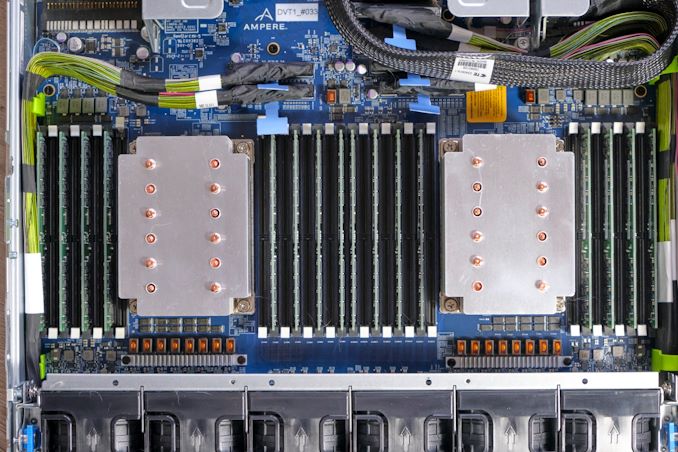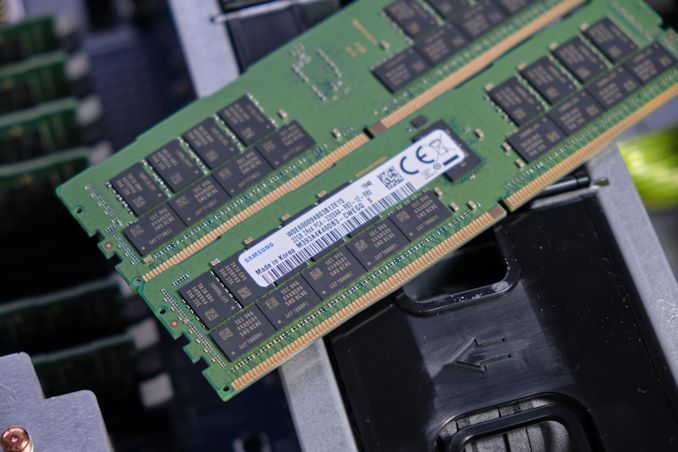The Ampere Altra Review: 2x 80 Cores Arm Server Performance Monster
by Andrei Frumusanu on December 18, 2020 6:00 AM EST- Posted in
- Servers
- Neoverse N1
- Ampere
- Altra
Test Bed and Setup - Compiler Options
For the rest of our performance testing, we’re disclosing the details of the various test setups:
Ampere "Mount Jade" - Dual Altra Q80-33
Obviously, for the Ampere Altra system we’re using the provided Mount Jade server as configured by Ampere.
The system features 2 Altra Q80-33 processors within the Mount Jade DVT motherboard from Ampere.
In terms of memory, we’re using the bundled 16 DIMMs of 32GB of Samsung DDR4-3200 for a total of 512GB, 256GB per socket.
| CPU | 2x Ampere Altra Q80-33 (3.3 GHz, 80c, 32 MB L3, 250W) |
| RAM | 512 GB (16x32 GB) Samsung DDR4-3200 |
| Internal Disks | Samsung MZ-QLB960NE 960GB Samsung MZ-1LB960NE 960GB |
| Motherboard | Mount Jade DVT Reference Motherboard |
| PSU | 2000W (94%) |
The system came preinstalled with CentOS 8 and we continued usage of that OS. It’s to be noted that the server is naturally Arm SBSA compatible and thus you can run any kind of Linux distribution on it.
Ampere makes special note of Oracle’s active support of their variant of Oracle Linux for Altra, which makes sense given that Oracle a few months ago announced adoption of Altra systems for their own cloud-based offerings.
The only other note to make of the system is that the OS is running with 64KB pages rather than the usual 4KB pages – this either can be seen as a testing discrepancy or an advantage on the part of the Arm system given that the next page size step for x86 systems is 2MB – which isn’t feasible for general use-case testing and something deployments would have to decide to explicitly enable.
The system has all relevant security mitigations activated, including SSBS (Speculative Store Bypass Safe) against Spectre variants.
AMD - Dual EPYC 7742
For our AMD system, unfortunately we had hit some issues with our Daytona reference server motherboard, and moved over to a test-bench setup on a SuperMicro H11DSI0.
We’re also equipping the system with 256GB per socket of 8-channel/DIMM DDR4-3200 memory, matching the Altra system.
| CPU | 2x AMD EPYC 7742 (2.25-3.4 GHz, 64c, 256 MB L3, 225W) |
| RAM | 512 GB (16x32 GB) Micron DDR4-3200 |
| Internal Disks | OCZ Vector 512GB |
| Motherboard | SuperMicro H11DSI0 |
| PSU | EVGA 1600 T2 (1600W) |
As an operating system we’re using Ubuntu 20.10 with no further optimisations. In terms of BIOS settings we’re using complete defaults, including retaining the default 225W TDP of the EPYC 7742’s, as well as leaving further CPU configurables to auto, except of NPS settings where it’s we explicitly state the configuration in the results.
The system has all relevant security mitigations activated against speculative store bypass and Spectre variants.
Intel - Dual Xeon Platinum 8280
For the Intel system we’re also using a test-bench setup with the same SSD and OS image actually – we didn’t have enough RAM to run both systems concurrently.
Because the Xeons only have 6-channel memory, their maximum capacity is limited to 384GB of the same Micron memory, running at a default 2933MHz to remain in-spec with the processor’s capabilities.
| CPU | 2x Intel Xeon Platinum 8280 (2.7-4.0 GHz, 28c, 38.5MB L3, 205W) |
| RAM | 384 GB (12x32 GB) Micron DDR4-3200 (Running at 2933MHz) |
| Internal Disks | OCZ Vector 512GB |
| Motherboard | ASRock EP2C621D12 WS |
| PSU | EVGA 1600 T2 (1600W) |
The Xeon system was similarly run on BIOS defaults on an ASRock EP2C621D12 WS with the latest firmware available.
The system has all relevant security mitigations activated against the various vulnerabilities.
Compiler Setup
For compiled tests, we’re using the release version of GCC 10.2. The toolchain was compiled from scratch on both the x86 systems as well as the Altra system. We’re using shared binaries with the system’s libc libraries.












148 Comments
View All Comments
Josh128 - Friday, December 18, 2020 - link
Did you see the chip package? Its the size of an EPYC package. Im extremely doubtful its only 350mm^2.mode_13h - Sunday, December 20, 2020 - link
Look at where they show the bottom of the heatsink and it's small contact area. That shows the actual die is much smaller.Spunjji - Monday, December 21, 2020 - link
Doubt all you want - they have to put the pins for the interfaces somewhere, and that doesn't change much regardless of die size.Gondalf - Friday, December 18, 2020 - link
Obviousy it is a cpu of niche, not high volume like Intel or AMD. With a so large die we will not see many of these around. As usual only volume matter in Server worldSo no worries for X86.
eastcoast_pete - Friday, December 18, 2020 - link
Actually, those are a bigger threat to x86 than ARM chips like the M1 in Personal Computers. Server x86/x64 CPUs ist where AMD and Intel make a lot of their money. The key question for this and similar Neoverse chips is software support. If you can run your database or whatever natively on an ARM-native OS like Linux, these are tempting. Now, if MS would release Exchange Server in native for ARM, the threat would be even bigger.Gondalf - Friday, December 18, 2020 - link
Agreed about software, but i don't see problems for x86 dominance.Major sin of this design is die size, around 800mm2 looking photos in the article. On 7nm it means a very low cpu output; this issue will become even worse on 5nm.
So it is not a matter how good is a SKU but who have the real volume in server world. In past decades we have seen a lot of better cpus than x86 puppies, but in spite of this they all have lost their way.
The winner scheme is "volume". This is the only parameter that gives the dominance of a solution over another ones, expecially today with several and several millions/year of server SKUs absorbed by the market.
Altra is not born to beat x86, at least not in this crazy, old style, incarnation. They need to follow AMD (and shortly Intel) path instead of they will never be relevant.
Actual and upcoming advanced processes are not done for these massive things.
scineram - Saturday, December 19, 2020 - link
It's less than half that, you absolute retard moron.Wilco1 - Friday, December 18, 2020 - link
Apple's move to Arm does hit Intel's bottom line by many billions. A large percentage of AWS is already Graviton as more big customers are moving to it (latest is Twitter). Oracle is going to use Ampere Altra, and Microsoft is claimed to develop their own Arm servers.As Goldalf said, volume matters in the server world, and they are moving to Arm.
Spunjji - Monday, December 21, 2020 - link
I love Gondalf posts. Minimum-effort confirmation bias ramblings.eastcoast_pete - Friday, December 18, 2020 - link
That was my question also! Who fabs it, and what is their yield. This thing is quite big. Does anyone know if they overprovision cores so they can use those with small, very partial defects? At that size and those numbers of transistors, even a tiny probability of a defect can mean that the great majority of chips ends up in the circular bin (garbage).